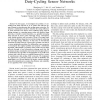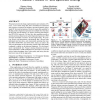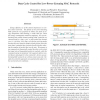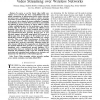138
Voted
INFOCOM
2012
IEEE
13 years 2 months ago
2012
IEEE
Abstract—In this paper, we investigate the problem of controlling node sleep intervals so as to achieve the min-max energy fairness in asynchronous duty-cycling sensor networks. ...
130
Voted
SIGCOMM
2012
ACM
13 years 2 months ago
2012
ACM
This paper presents the design, implementation and evaluation of Picasso, a novel radio design that allows simultaneous transmission and reception on separate and arbitrary spectr...
117
click to vote
JSAC
2011
14 years 3 months ago
2011
—Several contention-based Medium Access Control (MAC) protocols have been proposed for the vehicles to gain the radio channels to distribute active safety messages timely, e.g., ...
125
Voted
INFOCOM
2011
IEEE
14 years 3 months ago
2011
IEEE
—Body sensor networks (BSNs) have been developed for a set of performance-critical applications, including smart healthcare, assisted living, emergency response, athletic perform...
114
click to vote
TON
2010
14 years 6 months ago
2010
Aggregate traffic loads and topology in multi-hop wireless networks may vary slowly, permitting MAC protocols to `learn' how to spatially coordinate and adapt contention patte...
120
click to vote
MASS
2010
14 years 10 months ago
2010
Wireless sensor networks typically conserve energy by following a periodic wakeup-sleep schedule: nodes minimize idle time and spend most of their time in a low power sleep state. ...
105
click to vote
WIOPT
2010
IEEE
14 years 10 months ago
2010
IEEE
Abstract—In this paper, we present our results on the performance of MAC protocols in multi-hop wireless ad hoc networks in terms of the newly proposed metric “aggregate multi-...
121
click to vote
TMC
2010
14 years 10 months ago
2010
Energy efficiency is of the utmost importance in wireless sensor networks. The family of low-power-listening MAC protocols was proposed to reduce one form of energy dissipation�...
105
click to vote
JSAC
2010
14 years 10 months ago
2010
—To reserve or not for bursty video traffic over wireless access networks has been a long-debated issue. For uplink transmissions in infrastructure-based wireless networks and p...
126
click to vote
DC
2008
14 years 11 months ago
2008
A MAC protocol specifies how nodes in a sensor network access a shared communication channel. Desired properties of a MAC protocol are: it should be contention-free (avoid collisio...




